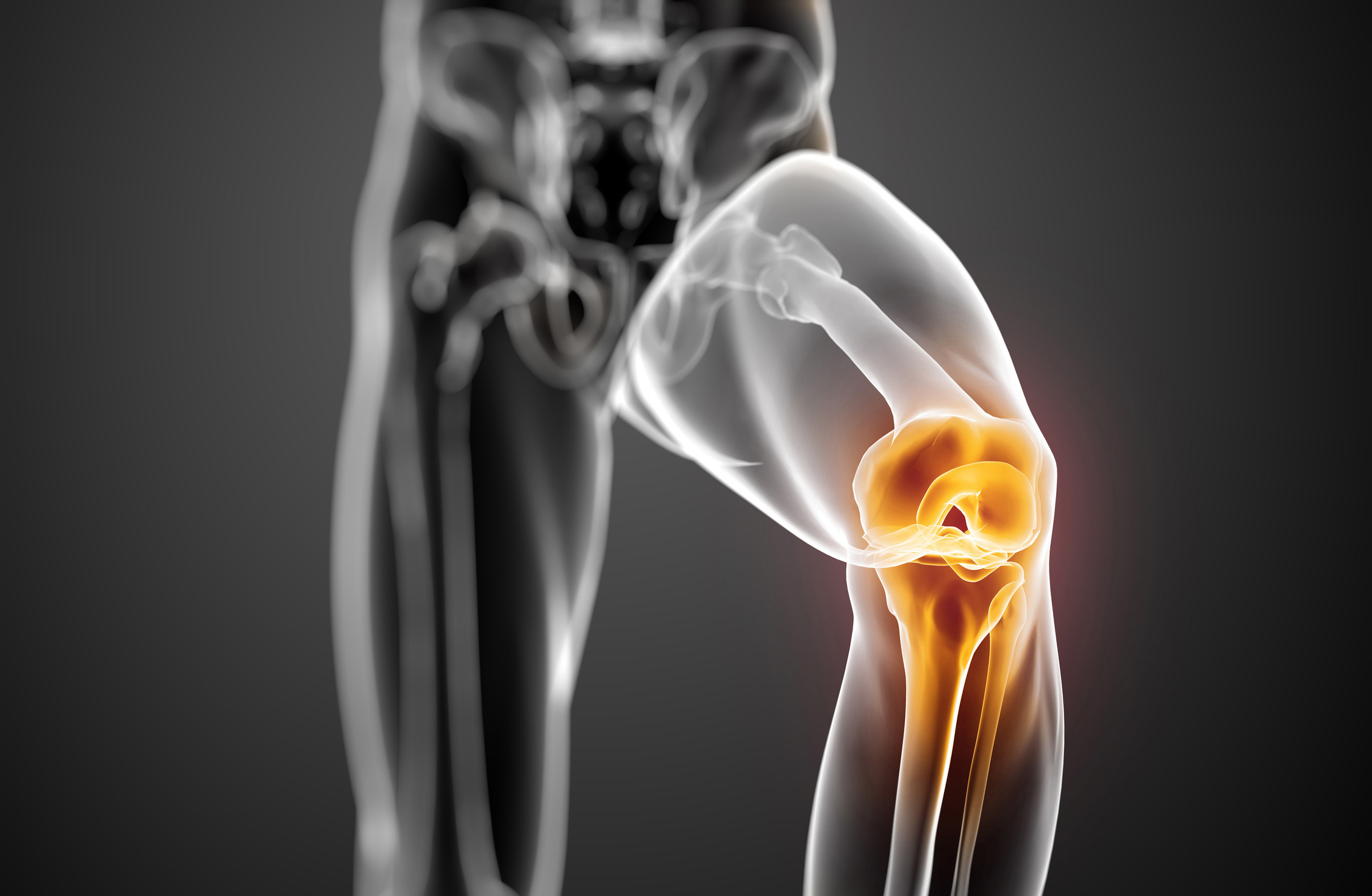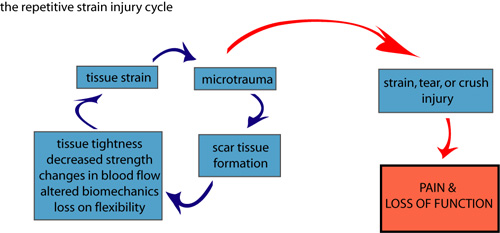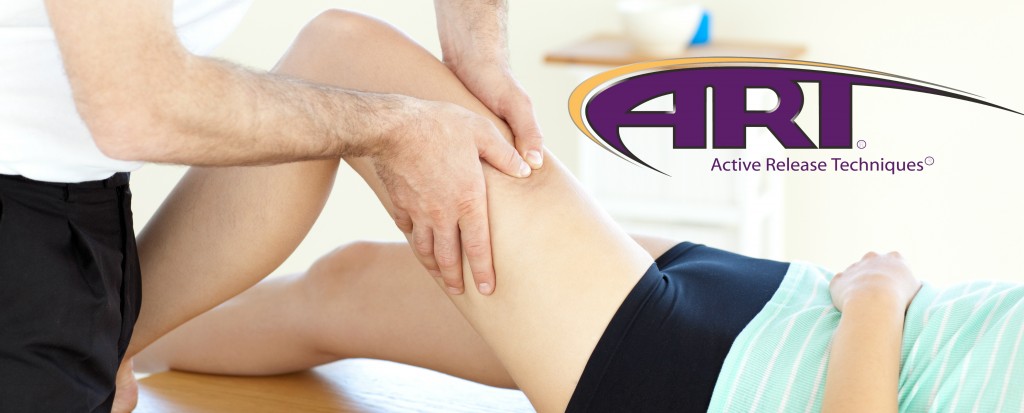Resolving Knee Pain with Active Release Techniques (ART)
Knee problems can be very frustrating. In fact, a painful knee can prevent you from enjoying your favorite things, such as walking, playing golf, exercising, or gardening. There are many instances where knee pain can even interfere with a good nights sleep. To make matters worse many common knee conditions are slow to respond to traditional types of care, often creating further disappointment and aggravation.
Now for the good news, a new treatment technique known as Active Release Techniques® (ART®) is proving to be a very effective method to treat many common knee problems and is helping to get knee pain sufferers back doing their favorite activities. But before we talk about how ART works so effectively we first need to understand how the knee becomes injured in the first place.
How Does Knee Pain Occur?
The knee consists of three bones – the Femur, Tibia, and the Patella, or knee cap. As the Femur and Tibia come together they form a hinge joint that is designed to move back and forth – movements that we refer to as flexion and extension. As you can see, the knee is designed to allow a large amount of movement, which is great because it permits us to do a wide range of activities such as walking, running, crouching, and kneeling. In order to move properly and protect the area from injury the knee joint relies on a complex system of muscles that surround area. These muscles include the thigh muscles – know as the quadriceps group, the hamstring muscles, the inner thigh muscles – known as the adductor group, the calf muscles, and also some smaller muscles around the knee, such as the popliteus muscle. Underneath these muscles there is also several strong ligaments that also help protect the knee joint. When the muscles are all working properly the knee moves as it should and the chance of pain and injury is very small. Unfortunately, it is common for these muscles to become tight and weak, which can lead to a variety of knee problems.
How Does Injury Occur?
We rely on the muscles that support and control the knee with virtually all of our daily activities. Simply climbing a flight of stairs or bending down to pick up the newspaper requires a complex interaction of the knee muscles to move and stabilize the area. With sports such as running, tennis, or golf the demand of the knee muscles is even greater. If any of the muscles that surround the knee become tight or weak it will place excessive strain on the other muscles and on the knee joint itself. Over time, if this imbalance in the muscles and resulting abnormal knee motion is allowed to continue it can eventually develop in more severe knee conditions.
There are a variety of situations that can cause tightness, weakness, and abnormal function of the knee. For example, repetitive use with certain sports or occupations, poor posture, lack of use, lack of stretching, muscle imbalances, or previous injuries can all affect the normal function of the knee and surrounding muscles resulting in excessive strain to the area.
Over time this strain can develop into what is know as micro-trauma. Simply stated, micro-trauma is very small scale damage that occurs in the muscles, tendons, joint capsules, and ligaments in response to small levels of strain. Initially this microtrauma is not painful, but may be perceived as a mild ache or tightness in the muscles. Although only small, this damage still needs to be repaired. The body responds to microtrauma in a predictable way by laying down small amounts of scar tissue to repair the injured tissue. Unfortunately over time this scar tissue will build-up and accumulate into what we call adhesions. As these adhesions form they start to affect the normal health and function of the muscles. In fact, they will often lead to pain, tightness, stiffness, restricted joint motion, and diminished blood flow.
As scar tissue adhesions accumulate in the muscles, tendons, and ligaments of the knee, it places more and more strain on the muscles as they must now stretch and contract against these adhesions in an attempt to move and stabilize the knee. This places even further strain on the knee muscles, which in turn leads to even more micro-trauma. Essentially a repetitive strain injury cycle is set-up causing continued adhesion formation and progressive knee dysfunction. At this point pain and tightness at the knee and surrounding area will start to become noticeable.
As this repetitive strain injury cycle continues the ability of the knee muscles to meet the demands placed on them diminishes. At this point it is not uncommon for the muscles to give way and a more severe and debilitating pain occurs. In fact, many patients come into our office explaining how they have knee pain but they did not really have any major type of injury occur. When further questioned these patients almost always describe some mild pain or tightness in their knee that has been building over time. As you can see from the explanation of the repetitive injury cycle, these types of injuries build-up over time until it eventually develops into larger scale injury.
Muscles and the Kinetic Chain Relationship
When discussing any type of knee problem we also need to review the relationship that the knee has with the other joints in the body, particularly the hip and the foot. It can be said that the knee is caught between the foot and the hip, and as such the foot, knee, and hip make up what is known as a kinetic chain. In fact, the majority of the muscles that act at the knee also cross either the hip or ankle joint. As a result of this relationship, with any knee problem both the foot and hip must always be closely examined as an abnormality in either area will greatly influence problems at the knee.
A common example of how the knee is influenced by the kinetic chain occurs in someone whose foot excessively pronates. Hyperpronation of the foot occurs when the foot excessively rolls inward, causing the foot to flatten out when walking and running. This will also cause the Tibia to rotate inwards, which in turn will result in a twisting stress at the knee. Not only will this result in injury to the knee joint itself, but it will also strain the muscles of the knee, hip, and foot as they have to work even harder in an attempt to control the excessive strain and combat the effects of the hyper-pronation. This will greatly magnify the effects of the repetitive strain cycle, further leading to knee dysfunction and injury. As you can see, even though pain may be at the knee the entire kinetic chain must be evaluated and treated to fully resolve the condition.
How Can These Knee Injuries Be Fixed?
The Traditional Approach…
In an attempt to relieve knee pain, a variety of treatment methods are used, either on their own, or in combination with other methods. Some of the more common approaches include anti-inflammatory medications, rest, ice, ultrasound (US), muscle stimulation (E-Stim), stretching and strengthening exercises, and when all else fails, surgery. Unfortunately, most of these traditional techniques generally require a long period of time before they provide any significant relief, and in many cases provide only temporary relief from symptoms instead of fixing the underlying cause of the problem.
The main reason that these approaches are often ineffective is that they fail to address the underlying scar tissue adhesions that develop within the muscles and surrounding soft tissues. It is these adhesions that are binding the tissues together, restricting normal movements, and interfering with the normal flexibility and contraction of the muscles in and around the knee.
Passive approaches such as medications, rest, ice, and ultrasound, all focus on symptomatic relief and do nothing to address the muscle restrictions and dysfunction. More active approaches such as stretching and exercises are often needed for full rehabilitation of the condition and to restore full strength and function of the muscles, however, they themselves do not treat the underlying adhesions. In fact, without first addressing the scar tissue adhesions, stretches and exercises are often less effective and much slower to produce relief or recovery from knee pain.
Active Release Techniques® Our Approach: ART® – A Better Solution
ART® stands for Active Release Techniques®. It is a new and highly successful hands-on treatment method to address problems in the soft tissues of the body, including the muscles, ligaments, fascia, and nerves. What makes ART® different from other treatments is that it is designed to identify and address scar tissue adhesions that are interfering with the normal function of the body. By locating and treating the soft-tissue adhesions with ART®, it allows the practitioner to, 1) break-up restrictive adhesions, 2) restore normal tissue translation and movement and 3) more completely restore strength, flexibility, balance, and stability to the knee and surrounding area.
You can think of an ART® treatment as a type of active massage. The practitioner will first shorten the muscle, tendon, ligament, or joint capsule, and then apply a very specific tension with their hands as you actively stretch and lengthen the tissues. As the tissue lengthens the practitioner is able to assess the texture and tension of the tissue to determine if the tissue is healthy or contains scar tissue that needs further treatment. When scar tissue adhesions are felt the amount and direction of tension can be modified to treat the problematic area. There are over 500 specific ART® treatment protocols which allow the practitioner to “feel” which structures have become problematic and require treatment. In this sense, each treatment is also an assessment of the health of the area as we are able to feel where the problem is occurring.
An additional benefit of ART® is it can allow us to further assess and correct problems not only at the knee, but also in other areas of the “kinetic chain” such as the foot, ankle, hips, and pelvis. This ensures that all the soft tissues that have become dysfunctional and are contributing to the specific knee injury are addressed, even if they have not all developed pain. One of the best things about ART® is how fast it can get results. In our experience, the majority of knee problems respond very well to ART® treatments, especially when combined with home stretching and strengthening exercises. Although each case is unique and there are several factors that will determine the length of time it will require to fully resolve the condition, we usually find a significant improvement can be gained in 6-8 treatments.




